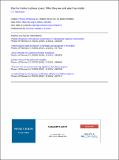Electron holes in phase space: What they are and why they matter
Author(s)
Hutchinson, Ian Horner
DownloadHutchinson AIP 2 PoP2017.pdf (3.828Mb)
PUBLISHER_POLICY
Publisher Policy
Article is made available in accordance with the publisher's policy and may be subject to US copyright law. Please refer to the publisher's site for terms of use.
Terms of use
Metadata
Show full item recordAbstract
This is a tutorial and selective review explaining the fundamental concepts and some currently open questions concerning the plasma phenomenon of the electron hole. The widespread occurrence of electron holes in numerical simulations, space-craft observations, and laboratory experiments is illustrated. The elementary underlying theory is developed of a one-dimensional electron hole as a localized potential maximum, self-consistently sustained by a deficit of trapped electron phase-space density. The spatial extent of a hole is typically a few Debye lengths; what determines the minimum and maximum possible lengths is explained, addressing the key aspects of the as yet unsettled dispute between the integral and differential approaches to hole structure. In multiple dimensions, holes tend to form less readily; they generally require a magnetic field and distribution-function anisotropy. The mechanisms by which they break up are explained, noting that this transverse instability is not fully understood. Examples are given of plasma circumstances where holes play an important role, and of recent progress on understanding their holistic kinematics and self-acceleration.
Date issued
2016-12Department
Massachusetts Institute of Technology. Department of Nuclear Science and EngineeringJournal
Physics of Plasmas
Publisher
American Institute of Physics (AIP)
Citation
Hutchinson, I. H. “Electron Holes in Phase Space: What They Are and Why They Matter.” Physics of Plasmas, vol. 24, no. 5, May 2017, p. 055601.
Version: Final published version
ISSN
1070-664X
1089-7674